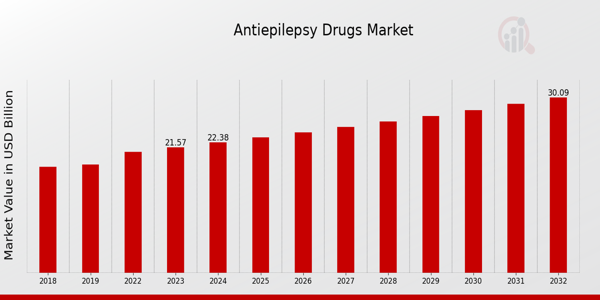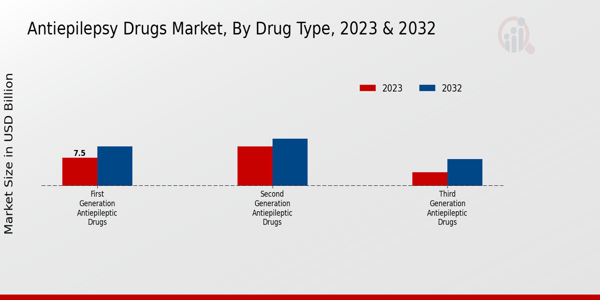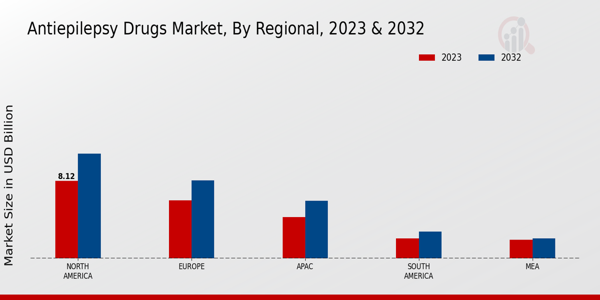Antiepilepsy Drugs Market Overview
As per MRFR analysis, the Antiepilepsy Drugs Market Size was estimated at 10.31 (USD Billion) in 2023. The Antiepilepsy Drugs Market Industry is expected to grow from 10.67(USD Billion) in 2024 to 15.5 (USD Billion) by 2035. The Antiepilepsy Drugs Market CAGR (growth rate) is expected to be around 3.46% during the forecast period (2025 - 2035).
Key Antiepilepsy Drugs Market Trends Highlighted
There are numerous significant trends in the Global Antiepilepsy Drugs Market, which are primarily driven by the growing prevalence of epilepsy and the demand for effective treatment options. The increasing recognition of neurological disorders and the significance of early diagnosis and management is a significant market driver.
Governments worldwide are emphasizing the enhancement of healthcare accessibility, which encompasses the availability of antiepileptic medications. Health authorities' initiatives underscore the necessity of effective treatment to alleviate the burden of epilepsy on society and individuals. The market is experiencing opportunities as a result of the advancements in drug development and the rise of personalized medicine.
Pharmaceutical companies are investigating innovative drug formulations that are tailored to specific patient populations based on genetics and seizure varieties. Additionally, the potential for growth is presented by the integration of technology into treatment approaches, including wearable devices for monitoring patient conditions and digital health solutions. This is consistent with the worldwide trend toward personalized healthcare and enhanced patient engagement.
Also, there has been a substantial shift in recent trends toward the development of biosimilars and generic pharmaceuticals, which are more cost-effective and can improve patient access to essential medications. Furthermore, global health initiatives that aim to address the unmet requirements in epilepsy care are fostering an increase in the frequency of collaborations between academia and industry for the research and development of new antiepileptic drugs.

Source: Primary Research, Secondary Research, MRFR Database and Analyst Review
Antiepilepsy Drugs Market Drivers
Rising Prevalence of Epilepsy Worldwide
The Global Antiepilepsy Drugs Market Industry is significantly influenced by the rising prevalence of epilepsy, which affects approximately 50 million people globally, as reported by the World Health Organization. This staggering number indicates a growing patient pool that requires effective treatment solutions. Furthermore, the increasing incidence of epilepsy in emerging markets due to factors like rising population and better diagnostic techniques further drives this market.
Established organizations such as the International League Against Epilepsy contribute to data collection and awareness campaigns, thereby enhancing the understanding of epilepsy's impact, which in turn boosts demand for antiepilepsy medications. The combination of these factors highlights the urgent need for innovative drug therapies, ensuring sustained growth in the Global Antiepilepsy Drugs Market Industry over the coming years.
Advancements in Drug Development Technologies
Innovations in Research and Development (R) are integral to the progress of the Global Antiepilepsy Drugs Market Industry. Breakthroughs in drug formulation and delivery methods have resulted in the introduction of novel antiepileptic drugs that offer improved efficacy and reduced side effects. Specifically, the use of nanotechnology in drug delivery systems has led to enhanced bioavailability of these medications. Major pharmaceutical companies are investing heavily in R, with expenditures surpassing billions of dollars annually.
This investment has been corroborated by data released by the Pharmaceutical Research and Manufacturers of America, emphasizing that R&D spending has been responsible for 50 to 60 new drugs introduced to the market per year. The continuous drive for improvement in treatment options will undeniably catalyze the growth of the Global Antiepilepsy Drugs Market.
Government Initiatives and Funding
Government initiatives focused on healthcare reforms and funding for epilepsy research play a crucial role in the Global Antiepilepsy Drugs Market Industry landscape. Many countries, particularly in the Global North, are increasing their investments in neurological disease research along with improved healthcare access. According to governmental reports, countries such as the United States have allocated significant funding to initiatives that specifically target better seizure control and patient management in epilepsy cases.
Additionally, funding from organizations like the National Institutes of Health aims to foster innovation in antiepileptic drug development. These government efforts not only enhance public awareness but also ensure that a greater number of patients receive access to effective treatment, subsequently boosting demand in the Global Antiepilepsy Drugs Market.
Antiepilepsy Drugs Market Segment Insights
Antiepilepsy Drugs Market Drug Type Insights
The Drug Type segment of the Global Antiepilepsy Drugs Market plays a pivotal role in delivering effective treatment options for individuals who have epilepsy. The market is experiencing significant growth, with a valuation of 10.67 USD Billion recorded in 2024 and projected to reach 15.5 USD Billion by 2035. Within this segment, Sodium Channel Blockers are particularly prominent, holding a valuation of 3.0 USD Billion in 2024 and expected to increase to 4.3 USD Billion by 2035. Their ability to stabilize neuronal membranes makes them a dominant choice in antiepileptic therapy, contributing to the majority holding of this market.
Following closely, GABAergic Drugs are valued at 4.0 USD Billion in 2024, anticipated to expand to 5.6 USD Billion by 2035; their mechanism of enhancing GABA activity is critical for seizure control. Meanwhile, Calcium Channel Blockers are projected to grow from 2.6 USD Billion in 2024 to 3.7 USD Billion in 2035, reflecting a growing acknowledgment of their role in modulating neurotransmitter release. Glutamate Receptor Antagonists, valued at 1.07 USD Billion in 2024 and expected to rise to 2.9 USD Billion by 2035, are emerging as an essential alternative treatment option, focusing on limiting excitatory neurotransmission.
The variations in market valuations indicate not just the therapeutic effectiveness of these drug types but also the increasing research investments and innovations aimed at enhancing their efficacy and minimizing side effects. This segment overall is benefitting from trends such as the ongoing Research and Development initiatives that aim to bring forth new formulations and delivery methods, meeting the needs of patients more effectively.
Challenges remain, including regulatory hurdles and market competition among generic alternatives. However, with a growing prevalence of epilepsy and a robust pipeline of new drugs under development, the Global Antiepilepsy Drugs Market is positioned for continued expansion in the coming years, highlighting the significance of each drug type within the overall framework of epilepsy treatment.

Source: Primary Research, Secondary Research, MRFR Database and Analyst Review
Antiepilepsy Drugs Market Therapeutic Classification Insights
The Global Antiepilepsy Drugs Market, focusing on the Therapeutic Classification segment, is poised for notable growth as it addresses the needs of diverse epilepsy types. In 2024, the market value is expected to reach 10.67 billion USD, indicating a strong demand for effective treatments.
The classification breaks down mainly into Partial Seizures, Generalized Seizures, and Status Epilepticus, with Partial Seizures representing a substantial portion of the market due to their prevalence globally. This segment is crucial as it reflects a common type of epilepsy that affects many individuals, necessitating ongoing treatment options.
Generalized Seizures, while also significant, showcase varying insights into treatment protocols, as they can present unique challenges in management. Status Epilepticus holds critical importance within this segment, as it represents a medical emergency requiring immediate intervention, thus accounting for vital research and development resources aimed at improving therapeutic outcomes.
Collectively, these classifications underscore the diverse nature of epilepsy and the focused responses required in the Global Antiepilepsy Drugs Market, which is projected to be valued at 15.5 billion USD by 2035, supported by ongoing advancements and a commitment to addressing various forms of the disorder.
Antiepilepsy Drugs Market Route of Administration Insights
The Global Antiepilepsy Drugs Market is segmented based on the Route of Administration, encompassing crucial options such as Oral, Intravenous, and Rectal deliveries. In 2024, the overall market is projected to be valued at 10.67 USD Billion, reflecting a growing focus on efficiency and patient adherence. Oral administration holds a significant presence, favored for its ease of use, which caters to long-term treatment for epilepsy. Intravenous administration is pivotal for acute treatment situations, particularly in emergency care settings, showing the dynamic need for rapid intervention in seizures.
Rectal administration, while less common, serves a specific purpose for patients unable to take medications orally, illustrating the diversity of administration methods catering to varied patient needs. The Global Antiepilepsy Drugs Market revenue reflects ongoing innovations in drug formulations and the development of tailored therapies for diverse demographics. Market trends indicate increased acceptance of these varied routes, driven by the demand for personalized medicine and the continuous expansion of treatment options available globally.With a projected market value reaching 15.5 USD Billion by 2035, the market growth emphasizes the evolving landscape where effective administration plays a crucial role in patient outcomes and therapeutic success.
Antiepilepsy Drugs Market Patient Age Group Insights
The Global Antiepilepsy Drugs Market segment related to Patient Age Group plays a vital role in addressing the specific needs of different demographics affected by epilepsy, which impacts millions globally. By 2024, the market is expected to be valued at 10.67 USD Billion, highlighting the significance of age-specific therapies in managing this complex condition. The market is segmented into Pediatric, Adult, and Geriatric categories, with each group exhibiting unique treatment requirements and challenges. The pediatric segment is crucial, as early intervention can significantly improve long-term outcomes for children diagnosed with epilepsy.
Adults generally present with different forms of epilepsy compared to pediatric patients, often requiring tailored medications to maintain their quality of life amidst varying health conditions. The geriatric population is becoming increasingly relevant, as age-related factors influence drug metabolism and efficacy, necessitating careful consideration in treatment selections. In the context of the Global Antiepilepsy Drugs Market revenue, understanding these age-related dynamics allows for effective targeting of therapies, ensuring that the specific demands of each age group are met, thereby driving growth in this essential market.
As awareness of epilepsy improves and therapeutic advancements continue, opportunities for innovation across all age groups will likely emerge, emphasizing the importance of tailored approaches in treating this neurologic disorder.
Antiepilepsy Drugs Market Regional Insights
The Global Antiepilepsy Drugs Market showcases a diverse regional landscape with significant economic implications. In 2024, North America is forecasted to generate substantial revenue of 4.45 USD Billion, making it a dominant player in the market and reflecting major advancements in healthcare infrastructure and access to innovative therapies. Europe follows with a valuation of 3.5 USD Billion, attributed to robust regulatory frameworks and a strong emphasis on Research and Development. The Asia-Pacific (APAC) region, while smaller with an expected 1.7 USD Billion, exhibits rapid growth potential due to increasing awareness and improvements in healthcare access.
South America is projected to reach 0.7 USD Billion, benefitting from rising investments in healthcare systems and the availability of generic antiepileptic drugs. The Middle East and Africa (MEA) holds the smallest market share at 0.32 USD Billion yet remains vital as countries enhance their healthcare policies and infrastructure to address neurological disorders. Each region reflects the unique socioeconomic conditions influencing the Global Antiepilepsy Drugs Market, illustrating varying levels of adoption and growth catalyzed by government initiatives and healthcare reforms.

Source: Primary Research, Secondary Research, MRFR Database and Analyst Review
Antiepilepsy Drugs Market Key Players and Competitive Insights
The Global Antiepilepsy Drugs Market is characterized by a diverse range of pharmaceutical companies, all vying for market share amid increasing demand for effective antiepileptic therapies. This competitive landscape is shaped by various factors, including the development of novel drugs, strategic partnerships, and the expansion of product portfolios aimed at addressing different forms of epilepsy.
Companies are investing significantly in research and development to introduce innovative treatments that can meet the needs of patients who do not respond to conventional therapies. The market is further influenced by the growing awareness surrounding epilepsy, leading to improved diagnosis rates and, consequently, a larger patient population requiring antiepileptic medications. As a result, the competitive insights within this market reflect a constant evolution driven by both scientific advancements and the strategic maneuvers of key market players.
Teva has established a solid presence in the Global Antiepilepsy Drugs Market, mainly due to its wide range of generic medications and specialty pharmaceuticals that cater to diverse patient needs. The company's strengths lie in its robust supply chain and extensive distribution network, allowing it to reach various geographical markets effectively.
Teva's commitment to innovation is evident in its ongoing investment in research and development focused on improving existing treatments and exploring new therapeutic options for epilepsy. This focus on innovation not only enhances its product offerings but also reinforces its position as a market leader. Moreover, Teva's collaborative efforts with healthcare providers and advocacy groups further strengthen its market presence as it seeks to develop solutions aligned with the needs of patients and their families.
Pfizer plays a significant role in the Global Antiepilepsy Drugs Market through its portfolio of antiepileptic medications, including various established brands recognized for their efficacy. The company's strengths stem from its strong research capabilities, backed by substantial investments in developing cutting-edge treatments aimed at improving patient outcomes in epilepsy management.
Pfizer's market presence is bolstered by strategic mergers and acquisitions, enhancing its ability to expand its therapeutic portfolio and integrate new technologies. The company's focus on continuous development has led to innovative formulations and delivery methods for its antiepileptic drugs, which cater to the evolving needs of patients and healthcare professionals. Pfizer remains committed to leveraging its global reach to deliver high-quality treatments while also engaging in initiatives that promote awareness and education about epilepsy, thereby solidifying its position in the competitive landscape of the antiepilepsy drugs market.
Key Companies in the Antiepilepsy Drugs Market Include
- Teva
- Pfizer
- Lundbeck
- AbbVie
- Roche
- Eli Lilly
- Johnson and Johnson
- GSK
- UCB
- Novartis
- Mylan
- Bristol-Myers Squibb
- AstraZeneca
- Amgen
- Sanofi
Antiepilepsy Drugs Market Industry Developments
The Global Antiepilepsy Drugs Market has witnessed significant developments in recent months. In September 2023, Teva launched a new formulation of its antiepileptic drug, enhancing treatment options for patients worldwide. Pfizer announced the expansion of its clinical trials for a novel antiepileptic medication aimed at addressing treatment-resistant epilepsy in October 2023. Lundbeck reported a growing interest in its innovative therapies, particularly for specific seizure types, emphasizing advancements in personalized medicine.
In terms of mergers and acquisitions, in July 2023, AbbVie acquired a startup focused on neurology, strengthening its portfolio in the antiepileptic segment. Roche and Eli Lilly both increased their investments in Research and Development for antiepileptic drugs, aiming to meet evolving patient needs. The market shows positive growth forecasts, with factors such as increased awareness of epilepsy disorders and expanding healthcare access driving demand.
Companies like Johnson and Johnson and GSK are also focusing on strategic partnerships to advance their drug pipelines, reflecting the competitive nature of the market. This momentum signifies a robust landscape for continued innovation and growth in the Global Antiepilepsy Drugs Market.
Antiepilepsy Drugs Market Segmentation Insights
Antiepilepsy Drugs Market Drug Type Outlook
-
- Sodium Channel Blockers
- Calcium Channel Blockers
- GABAergic Drugs
- Glutamate Receptor Antagonists
Antiepilepsy Drugs Market Therapeutic Classification Outlook
-
- Partial Seizures
- Generalized Seizures
- Status Epilepticus
Antiepilepsy Drugs Market Route of Administration Outlook
Antiepilepsy Drugs Market Patient Age Group Outlook
-
- Pediatric
- Adult
- Geriatric
Antiepilepsy Drugs Market Regional Outlook
-
- North America
- Europe
- South America
- Asia Pacific
- Middle East and Africa
|
Report Attribute/Metric
|
Details
|
|
Market Size 2023
|
10.31(USD Billion)
|
|
Market Size 2024
|
10.67(USD Billion)
|
|
Market Size 2035
|
15.5(USD Billion)
|
|
Compound Annual Growth Rate (CAGR)
|
3.46% (2025 - 2035)
|
|
Report Coverage
|
Revenue Forecast, Competitive Landscape, Growth Factors, and Trends
|
|
Base Year
|
2024
|
|
Market Forecast Period
|
2025 - 2035
|
|
Historical Data
|
2019 - 2024
|
|
Market Forecast Units
|
USD Billion
|
|
Key Companies Profiled
|
Teva, Pfizer, Lundbeck, AbbVie, Roche, Eli Lilly, Johnson and Johnson, GSK, UCB, Novartis, Mylan, Bristol-Myers Squibb, AstraZeneca, Amgen, Sanofi
|
|
Segments Covered
|
Drug Type, Therapeutic Classification, Route of Administration, Patient Age Group, Regional
|
|
Key Market Opportunities
|
Emerging markets expansion, Novel drug development, Non-pharmacological treatments integration, Personalized medicine advancement, Increasing awareness and diagnosis.
|
|
Key Market Dynamics
|
Rising epilepsy prevalence, Increasing healthcare expenditure, Advancements in drug development, Growing patient awareness, Expanding therapeutic applications
|
|
Countries Covered
|
North America, Europe, APAC, South America, MEA
|
Frequently Asked Questions (FAQ) :
The Global Antiepilepsy Drugs Market is expected to be valued at 10.67 USD Billion in 2024.
By 2035, the market is anticipated to reach 15.5 USD Billion.
The market is expected to grow at a CAGR of 3.46% during the period from 2025 to 2035.
North America is expected to hold the largest market share, valued at 4.45 USD Billion in 2024.
The market size for Europe is projected to reach 5.1 USD Billion by 2035.
Sodium Channel Blockers will be valued at 3 USD Billion, GABAergic Drugs at 4 USD Billion, Calcium Channel Blockers at 2.6 USD Billion, and Glutamate Receptor Antagonists at 1.07 USD Billion in 2024.
The APAC market size is expected to reach 2.3 USD Billion by 2035.
Major players in the market include Teva, Pfizer, Lundbeck, AbbVie, Roche, Eli Lilly, and several others.
The market faces challenges such as stringent regulatory requirements and competition from generic drugs.
The market value for South America is projected to be 0.7 USD Billion in 2024.


















